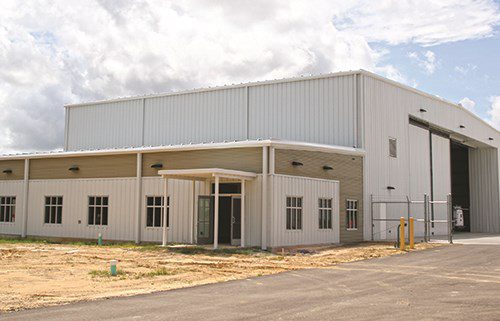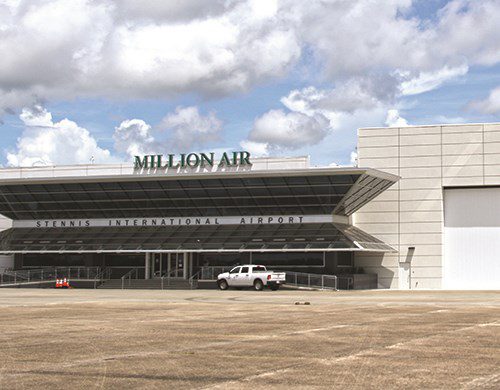There’s nothing ordinary about the traffic at Stennis International Airport (HSA) in southwestern Mississippi, so it stands to reason that many of its facilities are unconventional as well. Located near several U.S. military installations, the airport’s sole 8,498-foot runway is frequently used for pilot and equipment testing. Usually twice a week, HSA shuts off the airfield lighting so pilots from Keesler Air Force Base, the U.S. Marine Corps and U.S. Coast Guard can practice flying C-130J transport aircraft with night vision goggles.
There’s nothing ordinary about the traffic at Stennis International Airport (HSA) in southwestern Mississippi, so it stands to reason that many of its facilities are unconventional as well. Located near several U.S. military installations, the airport’s sole 8,498-foot runway is frequently used for pilot and equipment testing. Usually twice a week, HSA shuts off the airfield lighting so pilots from Keesler Air Force Base, the U.S. Marine Corps and U.S. Coast Guard can practice flying C-130J transport aircraft with night vision goggles. The airfield also has three drop zones for parachuters and cargo drops, four forward-arming and refueling points, three confined spaces for helicopter landing zones and three open-field training zones (see sidebar below).
 Recently, however, HSA focused on more typical infrastructure when it added more than 47,000 square feet of hangar space to its portfolio.
Recently, however, HSA focused on more typical infrastructure when it added more than 47,000 square feet of hangar space to its portfolio.
The Hancock County Port and Harbor Commission, which owns and operates HSA, sees the small general aviation airport as a vital economic development tool for the county and region. To that end, it doesn’t measure the airport’s performance by enplanements, but rather in the number of jobs it helps bring to the area. Because hangar space goes hand-in-hand with recruiting companies that will fuel economic growth, the Commission recently increased capacity at HSA by purchasing an existing hangar and constructing two others.
|
facts&figures Project: Hangar Construction & Purchase Location: Stennis Int’l Airport — Kiln, MS Airport Owner/Operator: Hancock County Port & Harbor Commission Project Cost: $7 million to construct 2 new hangars; $844,000 to purchase additional hangar Engineer: Michael Baker Int’l Key Objective: Increase hangar space to support growing aeronautical & space industries in the region
RESTORE Hangar Size: 24,000 sq. ft. Cost: $5.25 million Funding: $3.4 million from Hancock County Port & Harbor Commission; $1.85 million from RESTORE Act (result of settlement between state of Mississippi & BP over 2010 oil spill) Engineering: Michael Baker Int’l General Contractor: Drace Construction Corp. Hangar Door: Well Bilt Industries Construction: Sept. 2019-Sept. 2021 Lessee: Tyonek Services Group which provide aircraft maintenance services to U.S. Department of Defense, Boeing, etc.
New Corporate Hangar Size: 10,000 sq. ft., with additional 2,500 sq. ft. of office space Cost: $1.5 million Funding: $1.2 million from Hancock County Port & Harbor Commission; $325,000 MDOT Multimodal Grant Engineering: Michael Baker Int’l General Contractor: Mike Rozier Construction Inc. Hangar Door: Well Bilt Industries Completed: Sept. 2021 Associated Improvement: New concrete apron between hangars that connects to main ramp Lessee: Tyonek Services Group |
Bill Cotter, chief executive officer for the Port and Harbor Commission, monitors how well the airport supports local manufacturing and commerce by ensuring the availability of enough on-field support, maintenance and repair facilities.
New Hangars
Last September, the airport completed construction of a 24,000-square-foot hangar that opens directly to the main ramp with a door from Well Bilt Industries that is 154 feet wide and 28 feet high. Airport personnel refer to the new facility as the RESTORE Hangar because it was partially funded with money from the RESTORE Act, an outcome of the state’s settlement with BP over the 2010 Deepwater Horizon oil spill. The state of Mississippi used $1.85 million of its settlement funds to support the hangar project at HSA; Hancock County Port and Harbor Commission invested the remaining $3.4 million.
A 10,000 square-foot corporate hangar, also completed last September, is located south of the RESTORE hangar. A new concrete apron between new facilities provides ramp access for both hangars.
In addition to hangar space, the new corporate facility includes 2,500 square feet of office space, making it ideal for aerospace companies that need aircraft storage and space for administrative staff. The office space is unfinished so it can be customized to suit the specific needs of prospective tenants.
The Port and Harbor Commission invested $1.2 million of its own funds to construct the corporate hangar and new apron; a Multimodal Grant from the Mississippi Department of Transportation provided $325,000. The project, which was awarded to Mike Rozier Construction Inc., took one year to complete. Michael Baker International was the engineering firm for both hangars and the new apron.
“We’re seeing continued demand for more hangar space as more Department of Defense contracts are coming down, and as more corporate aircraft are looking for places to operate,” Cotter explains. “The Port and Harbor Commission is committed to being the cornerstone of Mississippi’s aviation industry. Thanks to the support of federal and state partners, we invested over $7 million to support business operations.”
In recent years, Hancock County has added 230 new jobs and seen nearly $100 million in private capital investment in aerospace development. Additionally, the next generation of aerospace workforce will be trained locally at a $10 million development center that Pearl River Community College plans to build at the airport.
Meeting Tenant Requirements
Both of the airport’s newly constructed hangars and the 13,125-square-foot hangar it purchased for $844,000 have already been leased.
Tyonek Services Group, an aircraft maintenance company that serves both private and public sector clients, is leasing the RESTORE hangar. Because the lease agreement was reached when construction was nearly complete, a change order was needed for Drace Construction Corp. to upgrade the hangar’s fire protection system. As a service provider for the U.S. Department of Defense, Tyonek is required to operate from a building with a foam fire suppression system instead of the sprinkler system specified in the original hangar design.
Aaron Ladner, project manager with Drace Construction, notes that the prime contractor worked with the airport and project engineer (Michael Baker International) to minimize the cost and delay of the late-stage change order. In the end, switching the system to comply with the more stringent National Fire Protection Association 409 requirements cost an additional $189,000 and delayed completion by 86 days.

“The most relevant advice I can give any airport manager who is wanting to expand and find new tenants for hangars is, if possible, have the tenant that will occupy that area involved at the time the hangar is being designed to ensure you provide a space that is tailored to that specific tenant,” Ladner says.
Aside from upgrading the fire protection system, the project team faced standard issues associated with completing a major construction project on an operational airfield.
 “It would have been a whole lot easier to tell the airport to leave and let us build this hangar, but that was just not an option,” jokes Jeffrey May, an associate vice president with Michael Baker International.
“It would have been a whole lot easier to tell the airport to leave and let us build this hangar, but that was just not an option,” jokes Jeffrey May, an associate vice president with Michael Baker International.
To keep things running smoothly, the engineering team emphasized strategic phasing and instituted a strong safety plan that clearly delineated construction areas from aircraft operation areas. Weekly construction meetings with all parties kept everyone on track,
adds May.
Looking ahead, Cotter reports that partial funding is in place for constructing additional hangars within the next few years—one with 18,000 square feet of space and another similar in size to the corporate hangar completed last fall.
Ultimately, he would like to build at least one more hangar that is 100,000 square feet or larger. “We’re watching the steel market and the overall market to determine when the right time is to pull the trigger,” says Cotter.
Ladner, who grew up near the airport, notes that a lot has changed at HSA. “In all my years, I never remembered any construction, expansion or anything changing at the airport,” he reflects. “Now, things are getting built and people are constantly talking about expansion. That airport is definitely moving!”
|
Military Focus Unlike many airports, commercial airlines are not part of the business model at Stennis International Airport (HSA) in Kiln, MS. About 60% of its roughly 40,000 annual operations are for military and government use. With an 8,498-foot runway rated to accommodate the world’s largest aircraft, HSA serves traffic from nearby Columbus Air Force Base, Keesler Air Force Base in Biloxi, Pensacola Naval Air Station in Florida, the Naval Air Station Joint Reserve Base in New Orleans, and other military installations. The airport is also adjacent to John C. Stennis Space Center, NASA’s largest rocket engine test facility. Importantly, the runway is inside NASA’s 125,000-acre noise and vibration buffer zone. “With our experience working with different Department of Defense contractors, and also with the training missions from the various branches of the military, we’ve got a lot experience working with military partners,” says Bill Cotter, chief executive officer for the Hancock County Port and Harbor Commission, which owns and operates HSA. “Through the relationships we’ve built, military commanders and the contractors that serve them feel comfortable using our services.” About four times per year, the airport receives Antonov An-124 Ruslan, the second-heaviest gross weight production cargo airplane in existence. In fact, that aircraft may now be the world’s heaviest cargo aircraft. Some reports indicate that the larger Antonov An-225 Mriya (a one-of-a-kind) was destroyed earlier this year during the Russian invasion of Ukraine. The Antonov An-124 Ruslan that uses HSA delivers high-bypass turbofan engines to the Rolls-Royce Outdoor Jet Engine Test Facility at Stennis Space Center. |



